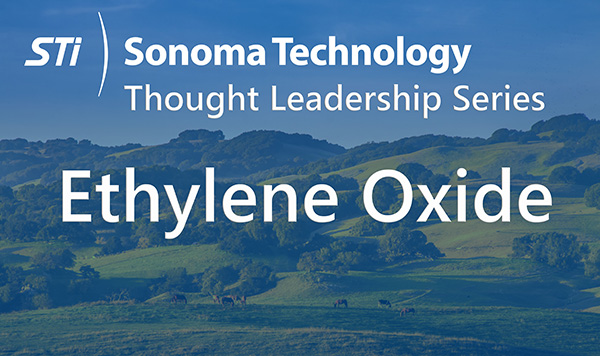Published May 2022
Ethylene Oxide (EtO) is a highly reactive gas with no color or odor that is used in a wide range of industrial facilities, including chemical manufacturing and medical sterilization. Its use is so widespread that the U.S. Food and Drug Administration (FDA) estimated EtO is used to sterilize 50% of medical and dental devices every year, which amounts to more than 20 billion devices.
As a result, the majority of historic regulations have applied to occupational use and stack emission release of EtO for these businesses. Little monitoring has been done to assess ambient levels of this gas in communities that are not located near sterilization or manufacturing facilities. However, recent research indicates that ambient EtO in some urban areas may be higher than previously thought, so regulations and technology have been increasingly focused on background levels that aren’t tied to specific sources.
In his recent article, my colleague, Dr. Steven Schill, describes recent emerging EtO regulations in the U.S. This article discusses the measurement technologies that are emerging to enable companies and communities to meet these regulatory monitoring requirements.
What Is the Acceptable Concentration?
The potential community exposure limit of a chemical is driven by both measurements and toxicology. For EtO, the U.S. Environmental Protection Agency’s (EPA) study of toxicology, Evaluation of Inhalation Carcinogenicity of Ethylene Oxide, resulted in a very low exposure limit for long-term exposure: 0.110 parts per trillion (ppt). This study also suggests that risks exist at the sub-ppt level.
This finding resulted in a revised acceptable ambient level of 11 ppt, as set by the Integrated Risk Information System (IRIS). This risk level was and still is significantly lower than what most available instruments can measure, highlighting the need for real-time, ultra-low-level measurement capabilities.
This acceptable background level is still being reviewed, and scientists are actively working to determine the ambient background level of EtO, though recent measurements from across the U.S. suggest an urban average of 111 ppt. One study found that the Los Angeles area had a population-weighted annual average concentration of 50 ppt of EtO in 1985, and more recent estimates place non-urban background average estimates for the northern hemisphere at 16 ppt. If this is true, then it could be difficult or impossible for communities and businesses to reduce ambient levels of EtO to less than 11 ppt.
How Is EtO Currently Measured?
The EPA Compendium Method TO-15A Gas Chromatography-Mass Spectrometry Canister (GC-MS) Analysis (updated in 2019) is a validated method for measuring ambient volatile organic compounds (VOCs), including EtO. Although this method is not truly ‘emerging,’ as it is the de facto standard given its use by EPA in ambient sampling programs, it should be included in any list of methods for EtO analysis. Air is collected into a specially treated canister and analyzed in a laboratory with GC MS, meaning data are not immediately available upon collection. This method provides EtO detection limits of between 20 and 90 ppt and has been the standard for measuring EtO in ambient air for decades, but regulations from the past several years require detection limits that are lower than this technology can measure.
Although TO-15A is in common use, questions remain about unusual observations that occur in routine application. Nevertheless, this method continues to be the dominant approach for the collection and analysis of integrated ambient air samples, especially for regulatory and compliance purposes.
Emerging Measurement Technologies
EtO has historically been difficult to measure because it is structurally similar to acetaldehyde, which has the same molecular weight of 44 g/mol. For example, both compounds exhibit similar fragmentation patterns when analyzed by GC-MS. Below are several emerging technologies at the forefront of ambient, whole air EtO measurement.
Key Takeaways
- Proton Transfer Reaction Spectrometry (Ionicon PTR-MS, both Quadrupole and Time of Flight): This instrument provides high sensitivity and real-time (one second or less) measurements of reaction products resulting from soft chemical ionization using hydronium ions (H3O+). PTR-MS bypasses the usual steps of chromatographic separation needed to detect the ions directly in the mass spectrometer analyzer, known as direct mass spectrometry, making it an ideal technology for ambient monitoring of a wide range of organic and inorganic compounds. This method is well suited for measuring concentrations relative to health and risk levels for many compounds, but mass interferences may complicate detection, as is the case for EtO. For Proton Transfer Reaction-Time-of-Flight-Mass Spectrometry (PTR-TOF-MS), it is necessary to either remove acetaldehyde or differentiate it from EtO due to the high mass resolution of this technique.Historically used primarily in research-oriented studies, PTR-MS and the similar Selected Ion Flow-Tube Mass Spectrometry (SIFT-MS) technique discussed below are now entering the mainstream measurement world. Currently, only a few providers offer these techniques, as they are costly and complex. Detection Limit: As low as 100 ppt for EtO.
- Selected Ion Flow-Tube Mass Spectrometry (Syft Technologies SIFT-MS): The Syft Technologies SIFT-MS instrument measures EtO and VOCs with direct mass spectrometry, which relies on the power of selected ion flow-tube detection for its specificity. The SIFT-MS instrument uses three reagent ions (H3O+, O2+, and NO+) for EtO detection, which switch on the millisecond scale and allow three modes of ionization to occur simultaneously. This feature also enables a wider range of compound detection without cumbersome gas changes. Efforts to distinguish between acetaldehyde and EtO are ongoing. The instrument can be mounted in a van or at a field site to measure ambient air, and can complete analysis within seconds. This capability was recently deployed in a fleet of 37 mobile laboratory vans in South Korea. Detection Limit: As low as 10 ppt for certain compounds, single-digit parts per billion (ppb) for EtO.
- Cavity Ring-Down Spectroscopy (Picarro G2920 Gas Concentration Analyzer): The Picarro G2920 uses cavity ring-down spectroscopy (CRDS), which measures the ring-down time of an optical signal in a highly reflective cavity to determine EtO concentrations. CRDS is known for its characteristically low detection limits and long-term stability, as well as robust specificity and reliability. Picarro offers two versions of this instrument: (1) the G2920, which is used to measure ambient EtO concentrations, and (2) the G2910, which is used for stack emission and indoor air quality testing. Detection Limit: 100 ppt for EtO.
- Preconcentration-enhanced CRDS (Entanglement AROMA-ETO): The Entanglement AROMA analyzer also uses CRDS and extends the number of compounds that can be measured with that technique. The instrument additionally uses ramped thermal desorption, a technique in which sampled air is drawn through a preconcentration sorbent tube, and temperature is slowly increased to analyze captured compounds with different volatilities. The AROMA can operate in either: (1) Rapid Scan Configuration, which is more typical of CRDS analyzers and provides measurements of one or several compounds every second; or in (2) Analysis Mode, which uses the ramped thermal desorption to measure an extended range of compounds at lower detection limits over a longer sampling time (roughly 15 minutes for EtO). It is on the leading edge of EtO measurement technologies and can be used for mobile or long-term remote monitoring. A recent test by EPA showed the 100-in-a-million risk level of 11 ppt was attained and verified by this instrument. Detection Limit: 11 ppt for EtO when the instrument is used in Analysis Mode.
- Fourier-Transform Infrared (MAX Analytical FTIR with StarBoost): Fourier-Transform Infrared (FTIR) spectroscopy converts the infrared (IR) radiation absorbed by a compound into an absorbance spectrum that can be used to identify many different compounds simultaneously. The MAX Analytical FTIR with StarBoost takes a unique approach to FTIR spectroscopy by optimizing its application for EtO as a single-gas measurement. The StarBoost configuration uses (1) a thermal oxidation module (TOM) to remove background interference, (2) a pressurized moisture knockout system, and (3) narrow bandpass filtering to reach much lower detection limits than is typical of FTIR for EtO and other compounds. This instrument conducts analysis in real-time and provides measurements in less than one minute. This instrument is used in both source and ambient testing. Detection Limit: 100 ppt for EtO.
- Mid-Infrared Spectroscopy (Aeris MIRA Pico Portable Middle Infrared Laser-Based Gas Analyzers): The Aeris MIRA Pico EtO Analyzer uses middle infrared (mid-IR) absorption spectroscopy with high-resolution tunable lasers to measure EtO in real time at low detection levels (1-2 ppb) with high accuracy. The analyzer is ultra-portable and is well suited for atypical surveys, including mobile and drone deployments, in addition to more typical long-term ambient monitoring. It offers noteworthy accuracy, stability, and detection capability at a competitive price that is less than half of most other offerings in its class. Detection Limit: 1-2 ppb for EtO.
- Technologies for measuring ambient EtO concentrations of less than 100 ppb and especially in the single-ppt range are still actively developing, while the acceptable ambient level of 11 ppt is still being evaluated and will potentially be refined. Technology is expected to continue advancing to meet the growing need to reliably measure EtO at extremely low concentrations.

Ryan C. Moffet

